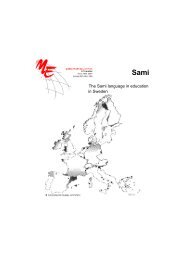Multilingual Early Language Transmission (MELT) - Mercator ...
Multilingual Early Language Transmission (MELT) - Mercator ...
Multilingual Early Language Transmission (MELT) - Mercator ...
You also want an ePaper? Increase the reach of your titles
YUMPU automatically turns print PDFs into web optimized ePapers that Google loves.
Yann<br />
Yann is a five-year-old boy whose parents have spoken French and Breton to him from birth.<br />
They both address him in either language and they both use both languages every day, as<br />
does almost everyone else who talks to Yann. When Yann's parents talk to him in French,<br />
they expect him to respond in French, and when they speak to him in Breton, they expect<br />
him to reply in Breton. Yann speaks both languages fluently and has playmates he speaks<br />
French with, and others he speaks Breton with. At his monolingual French medium<br />
preschool he mainly uses French, and occasionally some Breton with a friend he knows from<br />
his village. The teachers don't mind in the least and wish they could speak Breton<br />
themselves.<br />
Alana<br />
Four-year-old Alana is growing up in a Finnish-Swedish household. Until she was three years<br />
old, her parents spoke only Swedish to her, although they are fluent in Finnish, too. Alana<br />
herself spoke Swedish fluently by age two and a half. She then enrolled in a Finnish-only<br />
preschool. She wasn't speaking any Finnish until she was about three, though (she was silent<br />
at preschool). Her preschool teacher told her parents that this was because of the bilingual<br />
situation and urged the parents to start speaking Finnish instead of Swedish to Alana. With a<br />
heavy heart the parents gradually stopped speaking Swedish at home. This was very<br />
upsetting to Alana, who continued to speak Swedish to her parents for a while, but as she<br />
started to learn to speak better Finnish at school she gradually changed to speaking Finnish<br />
with her parents, too. Now that she is four she no longer speaks any Swedish.<br />
Pelle<br />
Six-year-old Pelle is growing up in a Frisian-Dutch bilingual household. His mother speaks<br />
Dutch and Frisian at home, and his father only Dutch. On his mother's side there are a few<br />
relatives who speak a bit of Frisian to Pelle now and then. Everyone in Pelle's environment,<br />
including school teachers and pediatricians, think it is great that Pelle is learning two<br />
languages. Pelle understands Frisian and Dutch, but he speaks only Dutch. This is puzzling to<br />
everyone and his mother is very sorry about it.<br />
Bronwyn<br />
Bronwyn is a perky five-year-old who heard only Welsh when she was very little. She started<br />
going to a bilingual preschool at age four and started learning English there. This added on to<br />
her fluent Welsh. While her English is not yet as well developed as her Welsh, Bronwyn can<br />
tell stories in either language. She will be continuing on to a bilingual primary school.<br />
The role of attitudes<br />
The way people feel about specific languages and child bilingualism has a strong effect on<br />
individual children's bilingual development. This is because these feelings or attitudes feed<br />
into people's behavior towards bilingual families and children, which in turn affects these<br />
families and children.<br />
92



